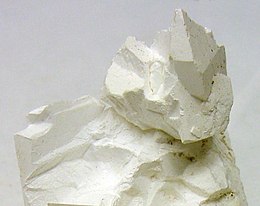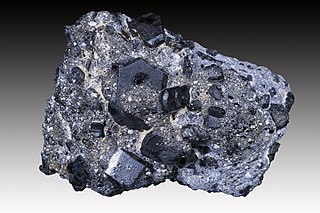
Augite is a common rock-forming pyroxene mineral with formula (Ca,Na)(Mg,Fe,Al,Ti)(Si,Al)2O6. The crystals are monoclinic and prismatic. Augite has two prominent cleavages, meeting at angles near 90 degrees.
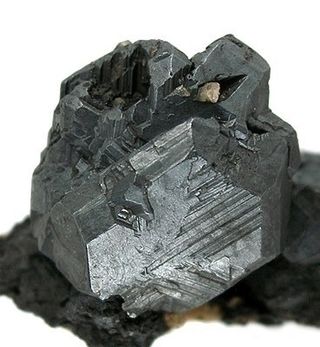
Chalcocite, copper(I) sulfide (Cu2S), is an important copper ore mineral. It is opaque and dark gray to black, with a metallic luster. It has a hardness of 2.5–3 on the Mohs scale. It is a sulfide with a monoclinic crystal system.
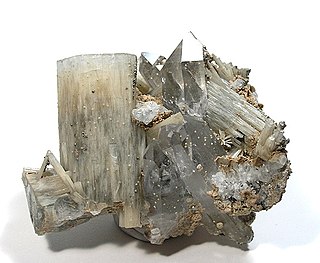
Zinnwaldite, KLiFeAl(AlSi3)O10(OH,F)2, potassium lithium iron aluminium silicate hydroxide fluoride is a silicate mineral in the mica group. The IMA status is as a series between siderophyllite (KFe2Al(Al2Si2)O10(F,OH)2) and polylithionite (KLi2AlSi4O10(F,OH)2) and not considered a valid mineral species.

Teallite is a sulfide mineral of tin and lead with chemical formula: PbSnS2. It occurs in hydrothermal veins and is sometimes mined as an ore of tin. Teallite forms soft silvery grey mica-like plates and crystallizes in the orthorhombic system. The Mohs hardness is 1.5 to 2 and the specific gravity is 6.4.

Lithiophilite is a mineral containing the element lithium. It is lithium manganese(II) phosphate with chemical formula LiMnPO4. It occurs in pegmatites often associated with triphylite, the iron end member in a solid solution series. The mineral with intermediate composition is known as sicklerite and has the chemical formula Li(Mn,Fe)PO4). The name lithiophilite is derived from the Greek philos (φιλός) "friend", as lithiophilite is usually found with lithium.

Aenigmatite, also known as cossyrite after Cossyra, the ancient name of Pantelleria, is a sodium, iron, titanium inosilicate mineral. The chemical formula is Na2Fe2+5TiSi6O20 and its structure consists of single tetrahedral chains with a repeat unit of four and complex side branches. It forms brown to black triclinic lamellar crystals. It has Mohs hardness of 5.5 to 6 and specific gravity of 3.74 to 3.85. Aenigmatite forms a solid-solution series with wilkinsonite, Na2Fe2+4Fe3+2Si6O20.

Phosgenite is a rare mineral consisting of lead carbonate chloride, (PbCl)2CO3. The tetragonal crystals are prismatic or tabular in habit: they are usually colorless and transparent, and have a brilliant adamantine lustre. Sometimes the crystals have a curious helical twist about the tetrad or principal axis. The hardness is 3 and the specific gravity 6.3. The mineral is rather sectile, and consequently was earlier known as corneous lead, (German Hornblei).

Kinoite is a light blue copper silicate mineral. It is somewhat scarce. It has a monoclinic crystal system, vitreous luster, and is transparent to translucent. It can be found in the Santa Rita Mountains, the Christmas Mine at Christmas, Arizona and a few other copper mines. Kinoite is popular with mineral collectors. Kinoite was named upon its discovery in 1970 after the pioneer Jesuit missionary Padre Eusebio Kino who worked in Arizona, Sonora and Baja California.

Cylindrite is a sulfosalt mineral containing tin, lead, antimony and iron with formula: Pb3Sn4FeSb2S14. It forms triclinic pinacoidal crystals which often occur as tubes or cylinders which are in fact rolled sheets. It has a black to lead grey metallic colour with a Mohs hardness of 2 to 3 and a specific gravity of 5.4.
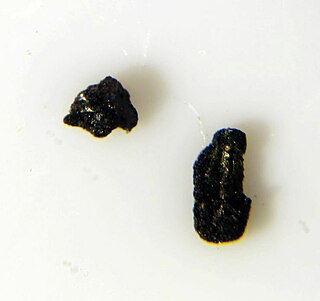
Stilleite is a selenide mineral, zinc selenide, with the formula ZnSe. It has been found only as microscopic gray crystals occurring as inclusions in linnaeite associated with other selenide and sulfides. It was originally discovered in Katanga Province, Zaire in 1956 and is named for the German geologist, Hans Stille (1876–1966).

Neptunite is a silicate mineral with the formula KNa2Li(Fe2+, Mn2+)2Ti2Si8O24. With increasing manganese it forms a series with mangan-neptunite. Watatsumiite is the variety with vanadium replacing the titanium in the formula.

Ordoñezite or ordóñezite is a rare tetragonal zinc antimonate mineral with chemical formula: ZnSb2O6.

Santabarbaraite is an amorphous ferric hydroxy phosphate mineral hydrate that was discovered in Tuscany, Italy during 2000. It also can be found in Victoria, Australia and Lake Baikal, Siberia.
Colimaite, the naturally occurring analog of synthetic K3VS4, is a sulfide mineral discovered in southwestern Mexico. The potassium-vanadium sulfide was collected from the crater of the Colima volcano. The mineral colimaite is named after the locality of this volcano and has been approved in 2007, along with its mineral name, by the Commission on New Minerals, Nomenclature and Classification (CNMNC). It has been given the International Mineralogical Association number of IMA 2007–045.
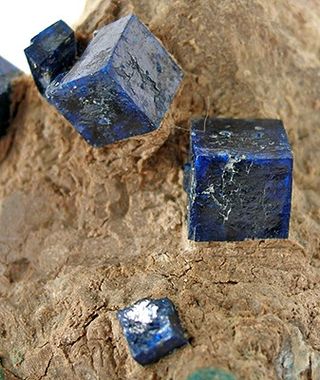
Boleite is a complex halide mineral with formula: KPb26Ag9Cu24(OH)48Cl62. It was first described in 1891 as an oxychloride mineral. It is an isometric mineral which forms in deep-blue cubes. There are numerous minerals related to boleite, such as pseudoboleite, cumengite, and diaboleite, and these all have the same complex crystal structure. They all contain bright-blue cubic forms and are formed in altered zones of lead and copper deposits, produced during the reaction of chloride bearing solutions with primary sulfide minerals.
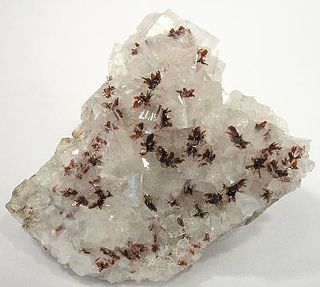
Ruizite is a sorosilicate mineral with formula Ca2Mn2Si4O11(OH)4·2H2O. It was discovered at the Christmas mine in Christmas, Arizona, and described in 1977. The mineral is named for discoverer Joe Ana Ruiz.

Junitoite is a mineral with formula CaZn2Si2O7·H2O. It was discovered at the Christmas mine in Christmas, Arizona, and described in 1976. The mineral is named for mineral chemist Jun Ito (1926–1978).
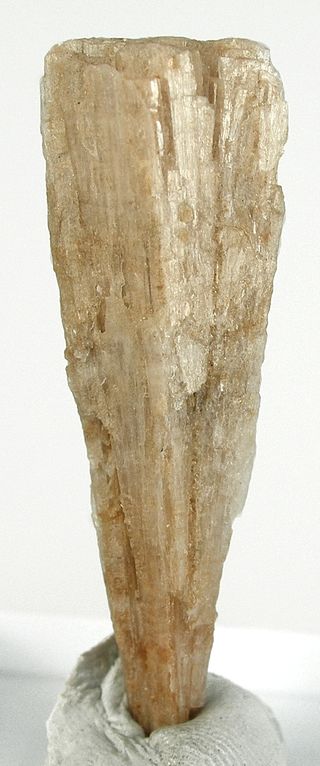
Syngenite is an uncommon potassium calcium sulfate mineral with formula K2Ca(SO4)2·H2O. It forms as prismatic monoclinic crystals and as encrustations.
Wulffite is an alkali copper sulfate mineral with the chemical formula K3NaCu4O2(SO4)4, in the sulfate category of minerals. It was recently discovered in Kamchatka, Russia at the Tolbachik volcano in 2012. It was named for Russian crystallographer Georgiy Viktorovich Wulff, a renowned expert who furthered X-ray diffraction and interference. Wullfite shares many properties with parawulffite, which was found in the same area just with slightly different chemical composition.
